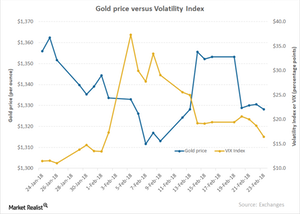How Is the Volatility Index Impacting Gold?
Another critical factor that has been affecting the price movement of precious metals is overall market volatility.
Feb. 28 2018, Updated 11:10 a.m. ET

VIX and gold
Another critical factor that has been affecting the price movement of precious metals is overall market volatility, which is depicted by the CBOE Volatility Index (or VIX). The index has been on the rise due to the unrest in the equity markets during the last one month. Global equity markets had seen sharp losses. Also, the worries about the interest rate hike have been critical in adding to the volatility in the market.
Gold and the Volatility Index can see high correlations during extreme uncertainty in the market. As gold is famously known as a safety asset, it usually rises when there is a significant slump in the market like the one in 2008. During market slumps, investors often take shelter in non-yield-bearing gold, as it can provide a buffer against risk.
Gold has historically been in sync with the Volatility Index (VIXY) (VXZ), though the connection between the two may not always hold strong during extreme uncertainty.
Correlation reading
The above chart shows the relationship between gold and volatility over the past one month. The result is quite contradictory to what we mentioned above. If we look at the correlation reading of gold to the VIX Index over the past two years, it has merely been 0.20.
Some of the mining companies that have also seen a loss on Friday due to the decline of precious metals include Franco-Nevada (FNV), Hecla Mining (HL), Agnico-Eagle Mines (AEM), and Sibanye Gold (SBGL). These stocks were up 1.7%, 1.6%, 0.77%, and 1.7%, respectively, on Friday.
